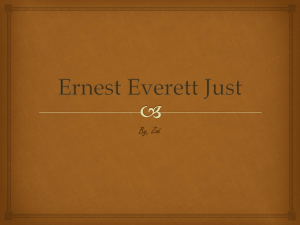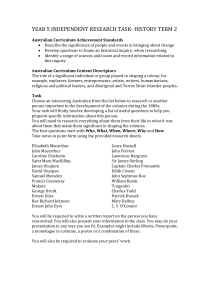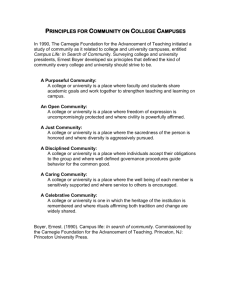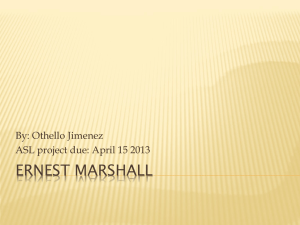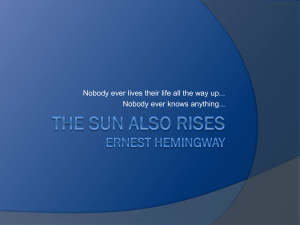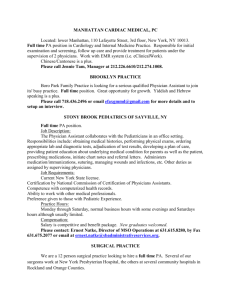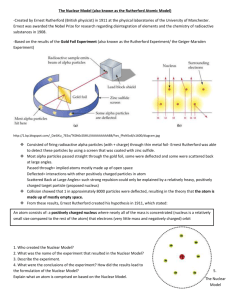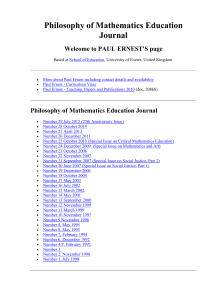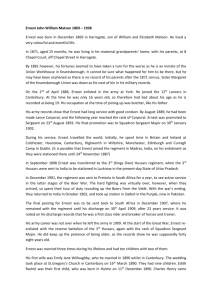Ernest Rutherford Kiwi Legend1 - Science Outreach
advertisement
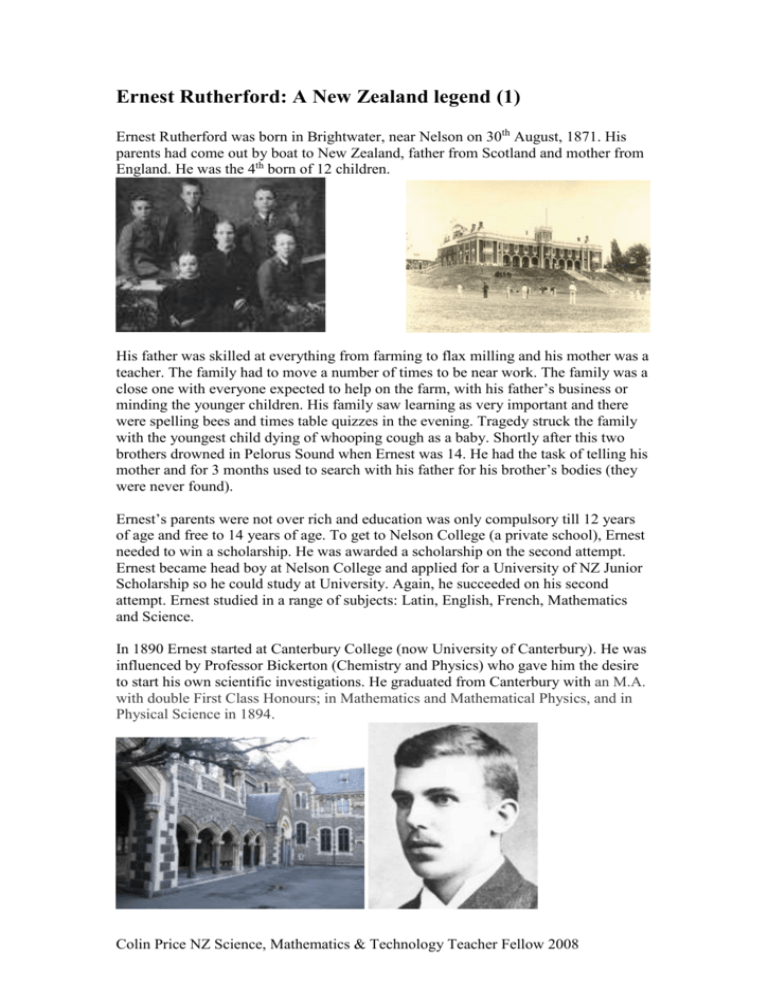
Ernest Rutherford: A New Zealand legend (1) Ernest Rutherford was born in Brightwater, near Nelson on 30th August, 1871. His parents had come out by boat to New Zealand, father from Scotland and mother from England. He was the 4th born of 12 children. His father was skilled at everything from farming to flax milling and his mother was a teacher. The family had to move a number of times to be near work. The family was a close one with everyone expected to help on the farm, with his father’s business or minding the younger children. His family saw learning as very important and there were spelling bees and times table quizzes in the evening. Tragedy struck the family with the youngest child dying of whooping cough as a baby. Shortly after this two brothers drowned in Pelorus Sound when Ernest was 14. He had the task of telling his mother and for 3 months used to search with his father for his brother’s bodies (they were never found). Ernest’s parents were not over rich and education was only compulsory till 12 years of age and free to 14 years of age. To get to Nelson College (a private school), Ernest needed to win a scholarship. He was awarded a scholarship on the second attempt. Ernest became head boy at Nelson College and applied for a University of NZ Junior Scholarship so he could study at University. Again, he succeeded on his second attempt. Ernest studied in a range of subjects: Latin, English, French, Mathematics and Science. In 1890 Ernest started at Canterbury College (now University of Canterbury). He was influenced by Professor Bickerton (Chemistry and Physics) who gave him the desire to start his own scientific investigations. He graduated from Canterbury with an M.A. with double First Class Honours; in Mathematics and Mathematical Physics, and in Physical Science in 1894. Colin Price NZ Science, Mathematics & Technology Teacher Fellow 2008 There was no future in scientific research work in New Zealand so Ernest applied for a scholarship (again) to research science at Cambridge University in England. He was successful second time (again!) and left for England in 1895 to study where Sir Isaac Newton had studied. He left behind May Newton, daughter of his land-lady, whom he had fallen in love with. They would marry nearly 5 years later. Interestingly, the faces on the New Zealand $10 note (Kate Sheppard), the $50 note (Sir Apirana Ngata) and the $100 note (Ernest Rutherford) all had a connection with Christchurch in the 1890s. In England he worked with a famous scientist called J.J Thomson who was interested in researching electricity and had discovered the electron. Ernest worked with radioactive elements like Uranium and discovered they gave out two different types of radiation that he called alpha (α) and beta (β). After 3 years at Cambridge he left for McGill University in Montreal, Canada. At the young age of 27 he had become a professor and was given the task of doing lots of experiments, to show that Canadian Universities were as good as American ones. Up to this time it was believes that atoms could not be divided. Ernest showed that some atoms did decay into other types of atoms. He measured how long it took to decay and developed the term half life i.e. the time it takes for half of the radioactive sample to decay. Ernest showed that the idea of half life of decaying radium atoms could be used in geology (history of Earth found in rocks) to date how old the Earth was. Ernest came back to New Zealand in 1900 to marry May and the following year they had a daughter, Eileen, who was to be their only child. By now his fame as a scientist was spreading. Ernest was being offered jobs at American Universities like Yale, but decided to return to England, so that he could be nearer other scientists and the research they were carrying out. When he left Canada in 1907 he had been nominated for the Nobel Prize by McGill University. Colin Price NZ Science, Mathematics & Technology Teacher Fellow 2008 Ernest Rutherford: A New Zealand legend (1) Questions Question 1 When was Ernest Rutherford born? Question 2 How many brothers and sisters did he have? Question 3 List 2 things that show that education was important to the family. Question 4 Give an example of difficult times that Ernest’s family faced. Question 5 What subject did Ernest take that is only studied by a few people today. Question 6 Give an example of Ernest showing determination (not giving up easily). Question 7 What age was Ernest when he graduated from Canterbury? Question 8 Who gave Ernest the start as an experimental scientist? Question 9 What was the advantage (benefit) of going to England? Question 10 Why was Cambridge University famous before Ernest arrived? Question 11 Who discovered the electron? Question 12 Smoke detectors use what type of radiation? Question 13 What name is given to someone at University who is in charge of a learning area? Question 14 What did people believe about atoms before Ernest? Question 15 The time for half a radioactive sample to decay is called the? Colin Price NZ Science, Mathematics & Technology Teacher Fellow 2008 Question 16 Name 2 radioactive elements. Question 17 Name one use of radioactive decay. Question 18 There will only be 25% (one quarter) of a sample of Uranium left after a) 1000 million years b) 2000 million years c) 713 million years d) 1426 million years Question 19 Give 2 reasons Ernest did not return to New Zealand to live? Question 20 How do we know that McGill University in Canada thought highly of Ernest? Colin Price NZ Science, Mathematics & Technology Teacher Fellow 2008 Ernest Rutherford: A New Zealand legend (1) Answers Question 1 When was Ernest Rutherford born? Question 2 30 August, 1871 How many brothers and sisters did he have? Question 3 11 (12 subtract himself) List 2 things that show that education was important to the family. Question 4 Spelling bees, times table quizzes Give an example of difficult times that Ernest’s family faced. Question 5 Question 6 Shifting to be near work / losing brothers What subject did Ernest take that is only studied by a few people today. Latin Give an example of Ernest showing determination (not giving up easily). Question 7 Getting 3 scholarships on the SECOND attempt What age was Ernest when he graduated from Canterbury? Question 8 23 (1894 subtract 1871) Who gave Ernest the start as an experimental scientist? Question 9 Professor Bickerton What was the advantage (benefit) of going to England? Question 10 Ernest could continue scientific research there Why was Cambridge University famous before Ernest arrived? Question 11 Newton had studied there Who discovered the electron? Question 12 J J Thomson Smoke detectors use what type of radiation? Question 13 Alpha / α What name is given to someone at University who is in charge of a learning area? Question 14 Professor What did people believe about atoms before Ernest? Question 15 They could not be divided The time for half a radioactive sample to decay is called the? Half life Colin Price NZ Science, Mathematics & Technology Teacher Fellow 2008 Question 16 Name 2 radioactive elements. Question 17 Uranium and radium Name one use of radioactive decay. Question 18 Date how old the Earth was There will only be 25% (one quarter) of a sample of Uranium left after e) 1000 million years f) 2000 million years g) 713 million years h) 1426 million years Question 19 Give 2 reasons Ernest did not return to New Zealand to live? Question 20 Few scientists or research opportunities How do we know that McGill University in Canada thought highly of Ernest? They nominated him for the Nobel Prize Colin Price NZ Science, Mathematics & Technology Teacher Fellow 2008
